 One of the most talked about aspects of the last two Masters tournaments has been the effect of the recent, dramatic architectural changes on the nature of the competition. Golf fans, like those of any sport with perhaps the exception of boxing, aren’t generally thrilled to see their champion determined in a war of attrition, stumbling over the corpses of their competition and limping across the finish line.
One of the most talked about aspects of the last two Masters tournaments has been the effect of the recent, dramatic architectural changes on the nature of the competition. Golf fans, like those of any sport with perhaps the exception of boxing, aren’t generally thrilled to see their champion determined in a war of attrition, stumbling over the corpses of their competition and limping across the finish line.
So it is no surprise that with the last two Masters Sundays (and perhaps the last several years’ worth of “toonaments”) featuring very few birdies and heroic charges among the eventual winners, many have concluded that the Augusta National Golf Club course has been changed for the worse. I’m not sure if there’s any merit to that argument, but I do know I’m pretty sick of hearing the whining. So for this week’s Thrash Talk, I decided to take a few vital signs on the tournament and today’s golf fan.
The Masters is of course the major championship we most identify with Sunday fireworks. Heroic final-round charges to victory by Palmer, Player, Nicklaus, and others have been well cataloged, and the tournament has long had the reputation of being the most beautiful and exciting of all the major championships.
All of the majors contrast sharply with the Masters in some way. The U.S. Open suffers from penal course set-up bordering on insane, the (British) Open Championship, often played on a browned-out links can turn out just about any way depending on the caprice of nature, and the PGA Championship resembles the U.S. Open, perhaps lacking quite the same bite and reputation.
For just about any seasoned golf fan, the Masters – with the beautiful springtime setting, a classic course inviting aggressive, heroic play, and often exciting, low scoring – is the ultimate major championship.
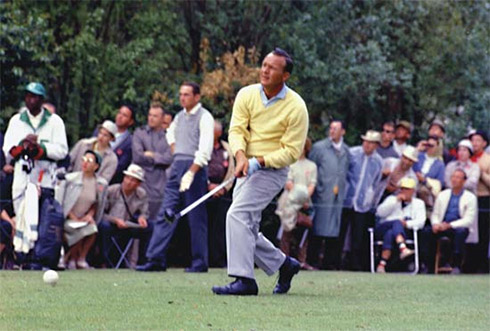
Arnie was the face of the Masters for a decade, but there were few scoring fireworks in his day.
That is the essence of the tournament as most of us know it, as it was played from the 1960s through the 1990s. But things began to change when Tiger came on the scene.
When Woods demolished the course in 1997, the members of Augusta embarked on a multi-year plan to update the course to keep it “current” with the skill level and playing styles of modern golfers. The changes have been relatively severe (see below), and the net affect has been a more difficult course. As for how this has affected the Masters, John Hawkins sums up the prevailing opinion best when he writes:
The world’s greatest golf tournament IS no longer the world’s greatest golf tournament, not in the context of how we once knew it, anyway. Gone are the Sunday afternoon fireworks, the four-hole birdie runs, the leader boards that changed faster than the arrival/departure screens at Grand Central Station. Power is now passé control rules the day. Love it or lament it, the azalea patch has grown fangs and chest hair, altering the competitive disposition of the Masters to a degree many would find easier to abhor than ignore.
Sounds serious, doesn’t it? But before I delve into why I abhor this kind of commentary, let’s put some numbers on the board and see exactly how much things have changed through the years. (All scoring data obtained from masters.org.)
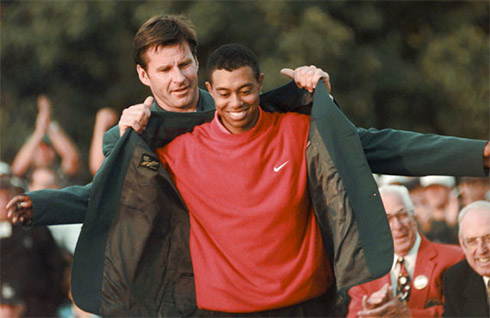
Tiger’s win in 1997 was the catalyst for major changes to Augusta National.
Below are some Masters scoring statistics I mined. I decided to look at six different eras in Masters history (special thanks to Ron Whitten for important insights on the architectural history of Augusta National Golf Club):
- 1949-56: Hogan/Snead Era, beginning of post-war, modern Masters. Changes to holes 11 and 16 put the course in it’s modern skeletal form, with modern routing and length (6900 yards) that was relatively stable for many years.
- 1958-65: The Arnold Palmer Era, and the beginning of Jack’s dominating years. No major changes in equipment technology or the course, although after Nicklaus’s arrival, some covert lengthening was performed in the mid- and late 1960s.
- 1971-78: The last phase of Jack’s heyday, and the beginning of Tom Watson’s reign. A relatively quiet period, both among golfers and the course.
- 1986-93: The end of Jack and Tom, rising prominence of European players, and transitional years pre-Tiger. Includes sampling of the first generation of Masters played on bentgrass greens. This major architectural change (1983), ushered in an era with superfast greens and, probably, increased demand on short-game finesse. First rumblings of major equipment changes to come, with metal woods, graphite shafts, and changes in ball technology all appearing here and there throughout the period.
- 1997-04: The Tiger Woods era. The beginning of major architectural changes to the course, and the establishment major changes in equipment technology, most notably universal use of titanium drivers, graphite shafts, and solid core golf balls.
- 2005-08: The Modern Era, with fully developed equipment technology. Course over 500 yards longer, with rough and trees narrowing the fairways, and deeper bunkers positioned farther from the tees. Teeing grounds moved on some holes to change angle of play.
The boundaries of these time periods were chosen arbitrarily, and I did not intentionally leave out any specific years. I wanted a few distinct subsets of tournaments that had some historical meaning. Remember, this is a semi-thorough look-see at some data, not a doctoral dissertation.
I chose to focus on scoring statistics of the winners and those in the top twenty, since these are the players we see on TV and the ones determining the overall drama of the tournament. With one obvious exception, all numbers are averages of the given statistic over the period of time indicated. All eras are eight years in length, with the exception of 2005-08.
Looking at the data very simply, it tells us a few things, quite obviously, I think.
Overall Scoring Trends
The first two graphs below show scoring average and the winner’s total score average, which I chose as surrogates for overall scoring trends at the Masters.
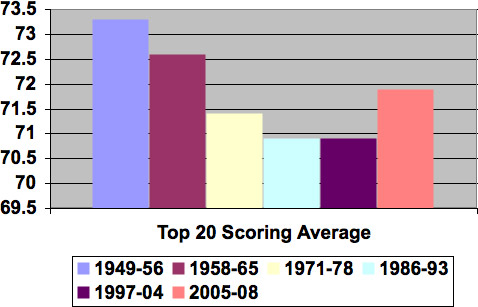
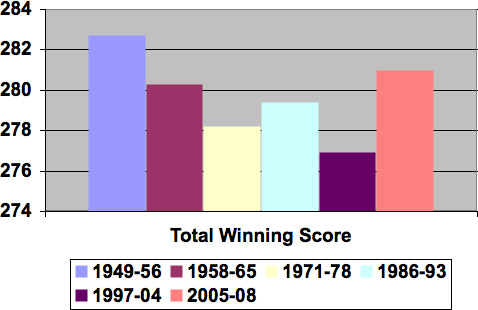
These data show a steady improvement in scoring overall between 1949 and 2004, with a little blip in the winners’ total in the first post-bentgrass era. Scores remained at historic lows during many of the early years of the post-Tiger course transformation, but have definitely increased in the last four years. So, between 1949 and 2004, players found Augusta progressively easier, probably due to overall improvement of player skill, perhaps better overall conditioning of the course over that period, and, in latter years almost certainly, improvements in equipment. Since then, architectural changes have turned the clock back on scoring, making it more difficult. But note that overall scoring is still better than in the Hogan/Snead era.
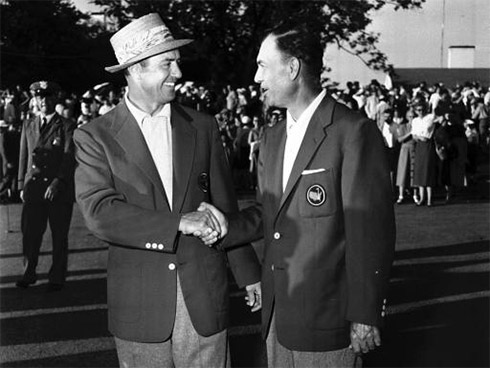
Modern course changes have players shooting much the same scores as the great Hogan and Snead.
Scoring and “Excitement Value”
To try to gauge the excitement value of the course, its potential to yield thrilling, final round charges, I looked at three additional statistics: the winner’s final-round score, the number of final-round scores below 70, and the low final-round score. If we’re talking excitement, if we’re interested in the course challenging players yet yielding to daring, aggressive play, it should show up in these stats. Here are the numbers:6
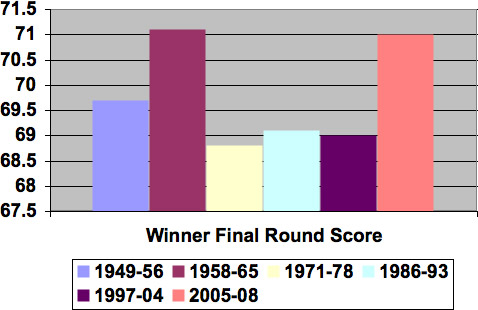
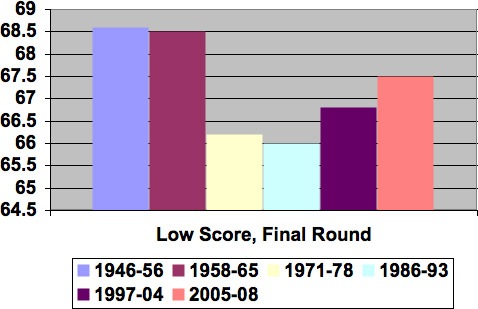
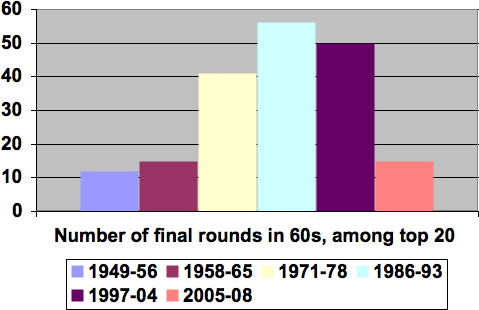
The most interesting stat may be the number of final round scores below 70. Note that the number was actually fairly low in the 1950s and 60s, then rose dramatically afterward. So, the exciting final-round charges aren’t really a historical constant of the Masters, but something slightly more recent.
As with total scoring, there is a slight reversal of the trend of rounds below 70 since 2004, but the number is nowhere near the level of the 1950s and 1960s. Note that in four years from 2005-08, the era of the most drastic changes in the course, the number of rounds in the 60s is already equal to or greater than the two oldest eight-year periods studied.
One interpretation of this data would be that recent architectural changes have managed to make the course more difficult and challenging overall, while maintaining the potential for sub-70 rounds at a level better than what was normal in the Hogan/Snead and Palmer eras.
In case you don’t like my sub-70 round as a reasonable definition of an exciting final round, I also counted the number of rounds below 67, among top-20 finishers, for each of the eras listed, and the trend is essentially identical to that of the sub-70 round analysis. Rounds of 66 or lower were vanishingly rare in the 50s and 60s, increased dramatically in the next three eras, and dropped off sharply in 2005-08. However, the rate of rounds below 67 is on pace to beat the 50s and 60s totals, as was seen with sub-70 rounds.
The data on low final-round scores, as might be expected, are similar to that of the number of sub-70 rounds. Winners’ final round scores are perhaps the toughest to interpret, perhaps because they contain fewer data points and are therefore more prone to random variation. Still, scores in the most recent period are not out of historical boundaries, although clearly they are higher than in most of Masters history.
So concerning Hawkins’ lament, the affects of recent course changes on the character of the Masters, my interpretation of these scoring statistics could be summarized as follows:
- Recent course changes have made scoring more difficult overall.
- Recent course changes have made it more difficult to score in the 60s and go ultra-low. But the potential to go low has not been eliminated, and is in fact still better today than in many memorable years in Masters history.
So the Hawkins commentary is correct, to a degree, but distorts the picture in an important way. I wonder if his opinion is overly influenced by the results of the last two tournaments, and perhaps myopically skewed toward more recent Masters history.
Maybe in the last two years we just haven’t had the winner get hot in the final round. Maybe it’s the weather, and maybe it’s just how it goes. Not every Masters had finishes like ’75, ’78, and ’86. Plus, this year Tiger Woods made the sort of heroic, final-round shots on the par-five holes, and other holes, that we like to see. He just didn’t close the deal by making the putts. Can we blame that on Hootie’s and Fazio’s rough and trees?
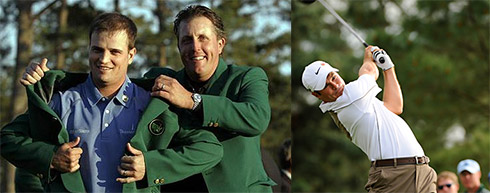
Is the Masters really dead, or are we simply unhappy with the lack of star appeal of recent champions?
Is the ultra-low, “tradition-unlike-any-other,” blistering final-round charge, back-nine 30 a thing of the past? Well, it’s certainly harder to shoot 65 there today than it was even five or six years ago, but don’t we have to be careful not to go too far with the fireworks, lest they become ordinary? The purpose of strengthening the course was to protect the validity and historical importance of those past great rounds, to adjust for modern advances in the game. Maybe they overshot the mark a little, but it’s off-base I think to suggest they ruined the tournament. And although I didn’t collect specific data on the number of Masters won with final round scores in the mid- to low 60s, I’m pretty sure you could count them on one hand. Doesn’t matter how easy they make the course, you’re not going to see that sort of thing every year, or even every five years.
What disturbs me even most, though, is not the specifics of the golf debate per se. It’s the tone of the debate, the premises underlying everyone’s angst. It’s as if we’ve forgotten that sporting events are contests between human beings, and not scripted playacts with outcomes engineered on request.
To me, modern information technology fuels this problem. Like 30-second, chopped-up porn videos on the web, we can see just about any exciting sports moment we want on YouTube. The TV networks, whether covering the World Series, NCAA Basketball Championship, or the Masters, serve up visually stunning, rapid-fire vignettes of every exciting moment in our sport’s history, giving us the illusion that great moments are the norm. People come to expect excitement, gratification, perfection, on a big scale, every time, on demand.
But that’s not the way things really are. Totally mediocre golfers (by professional standards, anyway) like Charles Coody, Gay Brewer, George Archer, and Tommy Aaron have won the Masters. Many, many players have won with final-round scores in the 70s, and without anything resembling a charge across the finish line. Despite what we may remember, it hasn’t been a 75-year thrill fest.
There are many people I like and respect a great deal who have been quite critical of recent Masters. I’m not saying they are wrong. But I can’t shake the notion that an important subset of golf fandom has gotten the wrong idea about sports. Please go ahead and complain; there wouldn’t be a PGA Tour or Masters (not a lucrative one, anyway) if it weren’t for fans, but can we manage to think a little before we complain?
You get the idea that some golf fans cannot be satisfied. Read the blogs…when a non-“glamorous” player like Immelman or Zach Johnson wins the Masters, with an ordinary final-round score, they complain the tournament is dead. When players tear up a tour event, they complain that modern equipment makes the game too easy.
A friend of mine pointed out to me a while back that sports contests are, in and of themselves, boring and almost meaningless to most of us. After all, what difference does it make who wins the Masters or what score they shot? Sports competitions are only important to us in that they are metaphors for our lives…the struggles, the ups and downs, the wins and the losses. Sometimes, life is just ordinary. Thankfully, I’ll add. If life were a 24/7 orgasm, I think the thrill would fade pretty fast, don’t you? OK, maybe you’d want to try your luck there, but you get my point.
At the very least, I urge golf fans everywhere to be patient. So far anyway, the data don’t tell a story of Judgement Day coming to the Masters, just a slight change, and not into uncharted waters, either. Let’s let ’em play for a while, and try to just sit and watch. When the spectacular moment comes along – and I believe it will – maybe we’ll appreciate it even more.
Photo Credits: © brittanica.com, courtesy of Arnold Palmer Enterprises, © brittanica.com, © Augusta.com, © NYTimes.com, © golfdigest.com

The problem with your knocking of the statements of others is that their statements likely don’t include the 50s and 60s. Hawkins was a kid back then, and I and my friends weren’t even around. However, I remember birdies and eagles from about 1992 onward. I remember Phil shooting a back-nine 31 en route to victory fairly recently. Including data from the 50s and 60s – when The Masters wasn’t even televised much – only serves to make your point. Others are making a different point. Start your charts in 1971 and the trend looks a bit different.
Furthermore, the past two years have seen some pretty crummy final-round weather, yet it’s simply made one of Augusta’s flaws all the more evident: they have no tees between the 6400-yard member tees and the 7400-yard toonamint tees. They can’t adjust the course to “add a little excitement” on days when the weather isn’t cooperating. Some say it’s only due to the rains and softer greens that we saw lower scoring going into the final round this year.
Holes like the 17th and the seventh has been “ruined” in the words of many great past Masters champs. The course offers no “let-up,” no place to catch your breath. More pros seem to be laying up rather than going for the green on the par fives. A lot of the past pros – and yeah, they can just be grumpy – have talked about the trees, the rough, and so on. Augusta used to be unassailable – now it seems to be a favorite target of criticism.
Recent memory’s all we’ve got – nobody remembers the 50s and 60s – and the trend from 1971 on is pretty clear to me: the Masters is getting increasingly less exciting.
By the way, what happened to 1957, 1966-1970, 1979-1985 and 1994-1996? I realize those dates don’t match up with any significant course changes, but if you took the averages instead of total counts, you wouldn’t need tidy eight-year blocks for everything. As it is, the graphs are somewhat suspect – how would the missing data change the graphs?
Thanks for your comments, Erik. I addressed the issue of the “missing years” in the article. I can go back and include them, I don’t think it would change the overall trends. I chose the years I did arbitrarily; I didn’t collect all the data and keep only what I wanted. The idea was to take an intelligent look at a reasonable chunk of data, not prove anything in a rigorous way.
If you go back and read the article, I point out that yes, Hawkins’ commentary is correct. The Masters course is harder, and it’s harder to go low. To say the tournament is “dead” is a severe condemnation of the scoring changes, and all I’m saying is I don’t agree. I realize there are few people writing on golf to day – me included – who remember much about the Masters before the 1970s. I never accused Hawkins of misinterpreting historical data.
I’m just trying to put the current tournament in broader historical context than what is implied by statements like Hawkins’.
I agree completely with your comments about the finer points of the architecture, including alternate teeing locations, etc. I wasn’t writing an architecture design critique per se, but if I did, that’s what I’d say.
And while on the subject of architecture, I’ll also say that many cork-sniffing architecture people such as Geoff Shackelford like to tell us that the “original intent” of classic designs like ANGC should be preserved, if possible. Obviously, significant length was needed at ANGC to eliminate the drive and pitch par 5s – I know you agree with this part of the changes. We can’t add the kind of length necessary to the course and not expect it to play a little harder.
As for the rough, well, I don’t know. I know Mackenzie and Jones are on record as detesting rough, but I think they were talking about something more severe than the Masters’ “second cut,” and I wonder if they ever envisioned that 99.5% of lies on their course would be agronomically perfect. As for the trees, eesh…and fundamental changes to the character of holes like 7, 14, and 17…well, maybe another time.
Correction–I chose the cutoffs for those time periods arbitrarily, not the years themselves. I wanted eras with some historical ‘tag.’
Something else interesting I heard someone say about the defensive play at recent Masters concerned equipment. Increases in distance over the past 8-10 years have made long fairway wood approach shots almost obsolete in golf. Not entirely, no, but certainly there are far fewer holes demanding a feathered 3 or 4 wood shot on today’s PGA tour. One person suggested to me that maybe today’s player simply isn’t as confident with this shot as prior generations were, and is therefore, for the moment anyway, a bit handcuffed by a long course like Augusta with dangerous water features fronting greens, etc.
If this is so, and if PGA Tour courses continue to lengthen, I’d expect players to shore up this potential hole in their shot arsenal over time, and perhaps take a few more chances at Augusta’s par 5s.
Well, i think something needs to be done about the equipment being used, as it propels the ball distances that could not have been imagined 40 to 50 years ago. The lengthening of the course at ANGC and the subsequent falling of the ‘excitement ratings’ is a reaction to technology that has become too forgiving.
Personally, im in favour of limiting driver head technology and the trampoline type measures that are currently being utilised. However, we have to consider the fact that on Sunday of this year’s competition the wind was howling making playing conditions treacherous at a course that had been set up in a punitive manner.
The sort of play witnessed this year and the decisions players were making was akin to that of the US Open- players taking high numbers, and damage limitation. However, as i have already mentioned in the forum, a lot of the criticism in my view has been borne out of the fact that Tiger did not win and there was no blistering shot making run from him in any of the rounds.
It was nice to see all the players struggle in a British Open fashion. It was good to see players manage their way around the track with anxiety aforethought. In my opinion, the courses played week in week out on the PGA tour are set up in a Target Golf style- where players can boom drives and attack the pins when they want to- if you re used to seeing that all the time, an intelligent play on a tough course comes as a shock to the system.
Jack Nicklaus’ initial concerns relating to technology a decade ago have proven to be legitimate, as we are witnessing a chain reaction in professional golf.
Hey JP, nice read. Thanks for gathering the data and for your analysis.
I gotta agree with you that a large part of the “problem” is today’s technology and TV coverage. Tiger’s popularity as a celebrity is also a contributing factor – for the average sports fan I think it can be argued that the Masters has lost some of its’ appeal compared to other sports.
As you pointed out so well, people today want instant gratification, and major championship golf does not provide that. Selfishly I think that maybe this dissatisfaction with the Masters and TV golf in general might make it easier for me to get a tee time and speed up play overall. But as a supporter of the game I think that the guys at Augusta National should listen to their customers and perhaps add some mid range tees, etc. Sure Tiger hit the shots and just could not putt as well as he normally does, but just think what some mid-range tees could have done for the tourney this year. I would have enjoyed more birdies on the weekend becuase the Masters DOES have a history of back nine charges on the last day. With this course setup that just ain’t gonna happen.
I said it above, too, and I wonder if the answer is really that simple. I wonder if, with some mid-range tees to help “add a dash of excitement,” that might not solve 90% of the problems people have (or think they have) with Augusta National.
I still think some holes, like 7 and 17, have greater problems than length, and I still despise the trees right on 11, but with added tees I wonder if that would solve the vast majority of people’s (players and viewers) issues. Hmmm.
JP: the gaps didn’t concern me, really, but the inclusion of data from before 1971 really helped to level out the best-fit lines. Exclude <1971 and they’d have some slant to them. So much that I’d be curious to see what the best fit line was for every year in these categories from 1965 onward looked like. Oh, well, perhaps a The Numbers Game column waiting to happen next spring…
I’ve heard rumors everyone might get their wish for alternate teeing grounds in 2009.
JP
Well written article. Some claim that the last two years have lacked “excitement.” I disagree. Had Tiger made some putts this year, we may have had a different ending. Still, watching the tournament and hoping he would make some putts, is part of the drama.
Secondly, regarding the weather, how often has this happened? I don’t remember every seeing the weekend look like this. This has to be a factor as two hitters not known for their length, Snedeker and Zack Johnson, were either in contention or won. Perhaps, to the casual fan, this is boring. To many fans of the game, who play target golf and smart golf, it’s a story line.
As for the final round, only two players broke par: Nick Watney and Miguel Angel Jimenez. Perhaps, then, that final round score does not seem so pedestrian?
Just my $.02.
By the way, when I saw your title, I thought it was going to be about the latest “Big Break.”:
😎 very well written piece, credit due where necessary, enjoyed the ead and thank you for the piece.
Sam